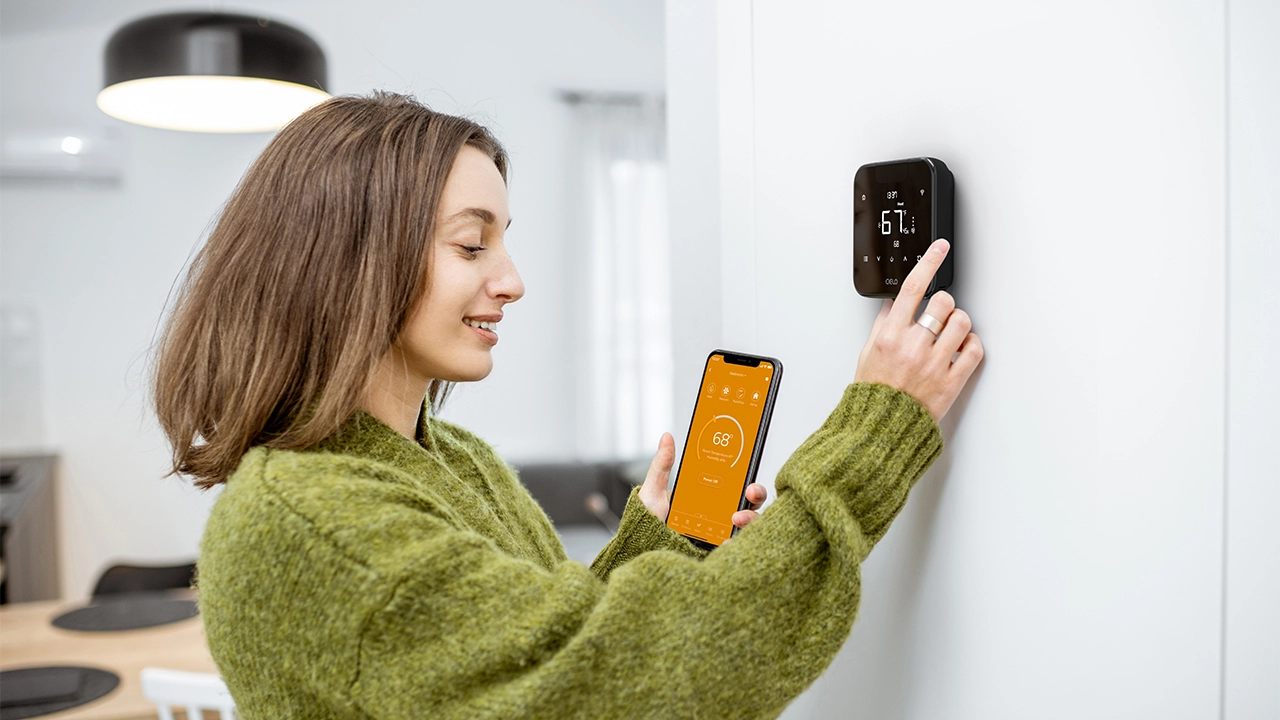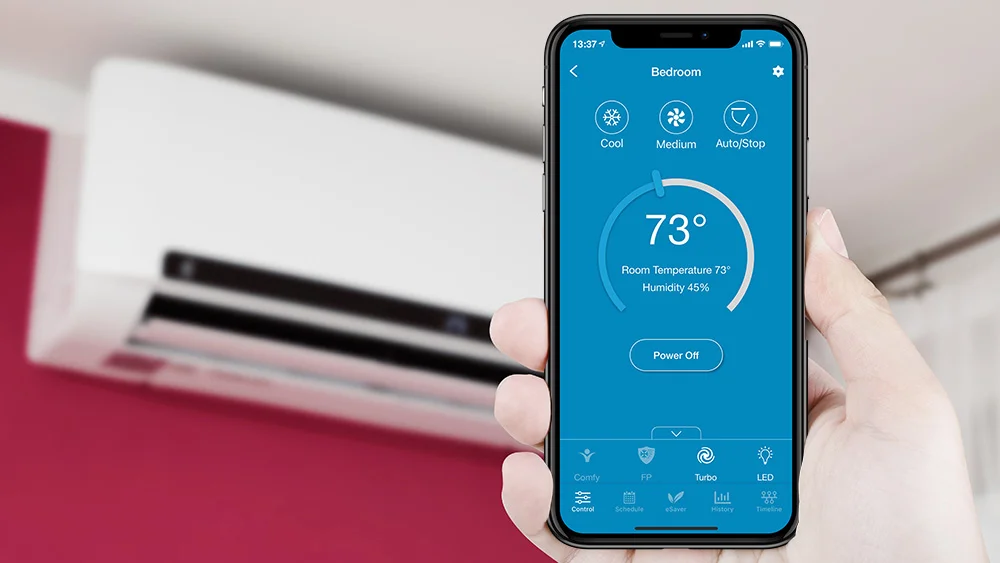
Key Takeaways
- Smart climate control devices optimize energy use with features such as scheduling and real-time adjustments.
- Smart appliances contribute to a greener home, lowering carbon footprints.
- Integration with other smart home devices creates a seamless experience for controlling your home climate.
With global market revenue for the smart home expected to reach $231.6bn by 2028, a sizable chunk will be owned by automated climate controls. Homeowners are increasingly adopting the use of smart climate control appliances to lower their energy bills and reduce their carbon footprint. From smart thermostats to smart air purifiers, these appliances not only provide convenience but also contribute to a greener, more energy-efficient home.
This blog explores the various smart climate control appliances you can install in your home. Discover how these devices can enhance your living environment and help you enjoy the benefits of a smart home.
- 1. Smart Thermostat for Central HVAC
- 2. Smart Mini-Split Thermostat
- 3. Smart Air Purifier
- 4. Smart Ceiling Fans
- 5. Smart Air Conditioner or Heat Pump
- 6. Smart Home Humidifier
- 7. Smart Home Dehumidifier
- 8. Smart Weather Station
- 9. Smart Space Heater
- 10. Smart Blinds
- 11. Smart Evaporative Cooler
- 12. Smart Vents
- The Takeaway
1. Smart Thermostat for Central HVAC

A smart thermostat offers numerous features that enhance comfort and efficiency. With the help of this home climate control appliance, you to manage your central system from anywhere in the world. It allows you to create personalized heating/cooling according to your routine. Once you have set your schedules, it will automatically implement your settings. Additionally, it includes energy-saving features, such as energy usage tracking, helping you identify opportunities to reduce energy consumption. Optimizing your HVAC system’s performance can significantly lower your energy bills while maintaining a comfortable environment.
Equip your HVAC system with smart features and achieve the perfect balance between comfort & savings.
Learn more
2. Smart Mini-Split Thermostat

If you own a mini-split system, a smart device like a mini-split thermostat is a must-have. It offers daily/weekly scheduling and can monitor your AC usage 24/7. You also get location-based controls that automatically turn off your AC when you leave and turn it back on when you arrive. In addition to mini-splits, you can also use it with other room units like window and portable ACs.
Cielo Breez mini-split thermostats have a super helpful feature called Comfy Mode, which uses intelligent temperature and humidity triggers to maintain an ideal home climate at all times! You can also pair these smart home climate control systems with voice assistants like Alexa or Google Assistant for hands-off control.
Your best choice to make any mini-split, window,
or portable AC smart. Enhance your comfort and savings.

3. Smart Air Purifier

An air purifier keeps indoor air quality in check and protects you from harmful airborne particles and chemicals. It removes dust, pollen, smoke, odor, mold spores, and dander from the air and pushes clean air back into the living space.
Smart air purifiers go one step further and provide real-time data on your indoor air quality. With a connected smartphone app, you can monitor your home air quality at any time, enabling you to make informed decisions—like whether to open windows during allergy season or increase the purifier’s fan speed for faster cleaning. Additionally, this smart home climate control system allows you to set schedules so they can automatically deep clean your living space before you arrive home. Some models even feature smart sensors that automatically adjust fan speeds based on the current air quality, ensuring a healthy home environment.
You can also buy air-purifying plants for a more budget-friendly solution and to add an aesthetic touch to your space.
4. Smart Ceiling Fans
Fans are a popular choice due to their lower purchase and operating costs compared to air conditioning systems. Now, smart ceiling fans have entered the market. These smart home climate control systems come equipped with Wi-Fi connectivity, which means you can control them using your phone. Some even have motion sensors, which means they can automatically turn on when someone enters the room and shut off when it’s empty. A smart fan can also adjust the speed and direction according to your preference and room conditions to maintain a comfortable environment.
Related: Do Ceiling Fans Cool a Room? Here’s The Best Ceiling Fan Direction for Cooling
To achieve the best energy-saving cooling around your home, you can use both air conditioners and fans together. The fan’s cooling effect allows you to set your AC at a higher temperature than usual while still enjoying a cool home.
Related: Fans vs AC: Which is better?
5. Smart Air Conditioner or Heat Pump

The basic operation of a smart air conditioner or heat pump is similar to that of traditional units. However, a smart unit can be connected to your home Wi-Fi, which means you can control it using your phone. Smart ACs have multiple smart modes and features to make them more convenient and help save on energy bills. You can set schedules, monitor your energy usage, and so much more. You can also program it to change temperatures when you leave or return home, ensuring that energy isn’t wasted on cooling or heating an empty house.
The best time to invest in a smart AC is when you are replacing your old unit. If your existing unit is working fine, you don’t need to spend a fortune to enjoy smart air conditioning. Instead, consider adding smart thermostats for room units. These climate control appliances offer smart functionality at a fraction of the cost of a smart AC, making it a budget-friendly option to enhance your home’s comfort and efficiency.
6. Smart Home Humidifier

Humidifiers can be great for your well-being. They help prevent the potential adverse effects of low humidity levels on your health. Dry winter air can lead to a itchy throat, skin or scalp, sinus problems, and more. Some humidifiers offer aromatherapy, which has been proven beneficial in lifting the mood and alleviating symptoms of depression and anxiety. You can also add essential oils to the humidifier to give a refreshing vibe to your living area!
The smart humidifier connects to your home Wi-Fi and can be easily controlled using your phone. It measures the humidity levels of the surrounding areas and helps maintain your ideal humidity levels. It shuts off automatically when the desired humidity levels are reached, and once they decrease, it starts working again.
You also can set your humidity target and add a schedule to operate them according to your routine. Humidifier maintenance is highly important, and smart humidifiers send automatic reminders when it’s time for their cleaning. This ensures that your indoor air remains clean.
Related: Where to Put Humidifier in Your Home & Other Frequently Asked Questions
7. Smart Home Dehumidifier

The key difference between a humidifier and a dehumidifier is their function: a humidifier increases humidity in dry indoor areas, while a dehumidifier reduces humidity in areas with excess moisture. Both devices, however, contribute to alleviating respiratory ailments such as asthma and chest congestion.
A dehumidifier extracts moisture from the air and collects it in a bucket. Reducing dampness can provide numerous benefits for your household, such as preventing mold growth, improving air quality, and protecting your home’s structural integrity.
Smart dehumidifiers can be easily controlled with your phone through Wi-Fi. You can set the mode, speed, humidity levels, etc., from anywhere. The auto-shutdown feature ensures that the device turns off when the water reservoir is full or after a certain period through smart scheduling.
Related: Humidifier or Dehumidifier: Which Is the Best Option for Your Needs?
8. Smart Weather Station
Weather forecasts provide updates, but remote stations installed miles away may not always provide accurate information about your area. For this purpose, home weather stations have been designed to monitor the climate exactly where they are installed. The sensors installed can measure temperature, humidity, and air pressure. Advanced models can even track wind speed and direction, rainfall, and UV levels in real-time.
Smart weather stations go one step ahead, as they do more than collect data. They provide all the relevant information on your phone and provide important notifications. The smart weather station is compatible with various voice assistants, which allows you to set up routines that get triggered based on weather conditions. For instance, the outdoor temperature information can be sent to your smart thermostat, which can then adjust the indoor temperature accordingly.
9. Smart Space Heater

Whether you want to counteract the chill in a drafty bedroom or provide extra warmth to your home’s heating system, it’s always good to have a space heater around. They are portable, and you can easily carry them around whenever they are required.
Smart space heater comes with Wi-Fi connectivity, allowing you to turn it on or off remotely, adjust the temperature, and set schedule heating times according to your preferences. They also provide safety features like automatic shutdown to prevent overheating and child safety locks. Advanced models of this climate control appliance also offer air quality monitoring, with built-in air purifiers that activate automatically when necessary.
10. Smart Blinds
Who would have thought that one day you could control your curtains using your phone – moreover, they would automatically open or close depending on weather conditions! With smart blinds, you can control your shades with a single click, while automated schedules free you from the hassle of setting the blinds multiple times a day.
Smart blinds come with sensors that measure light and weather conditions and automatically operate based on that. For instance, if it’s sunny outside in winter, they will open up during the day to bring in sunlight. If you have them paired with your smart thermostat, your heating will be lowered during this time, ultimately saving on energy consumption. You can also set Siri, Alexa, or Google Home routines for climate control, like automatically raising the blinds slightly in the morning for a refreshing wake-up.
11. Smart Evaporative Cooler
Evaporative coolers use water or ice to cool down the air. As they work just by using water and do not require any compressor, they utilize way less energy than air conditioners. However, they add humidity to the room so they are only suitable in dry climates. Room evaporative cooler has a compact design and size, and you can easily move it around wherever it is required. Smart evaporative coolers offer control through a mobile app or a voice assistant, so you can easily adjust settings no matter where you are.
Related: Evaporative Cooler vs. Air Conditioner: A Side-by-Side Comparison
12. Smart Vents
If you find that some rooms in your home feel cooler or warmer than others, smart vents provide the perfect solution. These home temperature control systems manage the temperature in individual rooms by automatically opening and closing to adjust airflow as needed. This allows for more precise control over the comfort level in each space.
Smart vents use motion and proximity sensors to detect activity in a room. If someone enters, the system can adjust the temperature based on its settings. Additionally, you can control the smart vents remotely through your smartphone, allowing you to manage your home climate even when you are away.
The Takeaway
Smart climate control appliances are revolutionizing the way you manage your environments, offering unparalleled convenience, efficiency, and comfort. From smart thermostats and air purifiers to ceiling fans and humidifiers, these devices work together to create an optimal indoor climate tailored to your preferences. By integrating features like remote control, automated scheduling, and real-time monitoring, they empower homeowners to reduce energy consumption and lower utility bills without sacrificing comfort.









2 Comments. Leave new
This is a great blog.
I love reading your site.